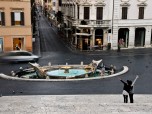For those who love history, especially Roman ancient history, Piazza Navona is definitely the place to visit. Piazza Navona, or Navona Square, as it is known in English, started as a stadium in Rome. Piazza Navona is one of the main places of interest in Italy and many tourists visit it as a result.
Beginning History
In 86 AD the Emperor Domitian reconstructed a stadium that was originally built by Caesar and Augustus. Greek athletic competitions were held here, and it was part of a huge multi-entertainment compound. Foot races and other competitive sports were played here. The stadium also housed plenty of brothels. Up to 20,000 spectators could be seated in the stadium to watch the games. Gymnastic competitions were also held and festivals were common, as the stadium had an arena larger than that of the Colosseum. In the third century, it was used as an amphitheater after a fire partially destroyed the Colosseum. From 217 to 228 AD the gladiatorial games were held here while the Colosseum was being repaired.
Fall of the Roman Empire
After the fall of the Roman Empire, the stadium basically fell in to ruin. During the middle ages, it was just mainly an open space. All in all, it became a public space where anyone could go. For this reason, the city market of Rome was transferred here by the end of the 1400’s. In spite of falling into ruins, the stadium gave the Piazza the shape it now has. It is still possible to see traces of the stadium around the north exit of the Piazza.
Piazza Navona Today
Bernini and Borromini designed most of the Baroque buildings that surround the Piazza Navona today. The three fountains in the Piazza are known as possibly the greatest works done by Bernini.
Cafes, restaurants, and nightclubs also populate the Piazza Navona, combining the modern with the ancient in this Square. Artist, entertainers, and souvenir vendors are everywhere. The best time for those seeking solitude in this area is during the early morning hours. Guided tours of Piazza Navona are also available.





































